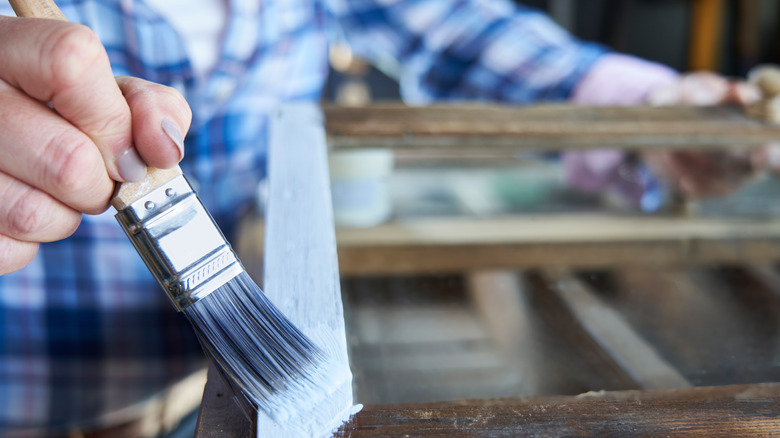The Ingenious Way To Reuse Plastic Bottles In Your Backyard Garden
Does your household go through lots of bottled water? Instead of tossing those plastic bottles into the recycling bin, stow them in your garage. Once you have a solid pile (we're talking a few hefty trash bags full), you'll have enough to craft your very own mini greenhouse to protect your dahlias from the cold winter weather or start those lettuce and pepper seeds earlier in the season. All you have to do is string the collected (and washed!) used bottles together on bamboo or other flexible poles and attach them to a box frame you crafted yourself from wood you upcycled (ideal) or bought new (also an option).
A couple of scientific processes, specifically thermal radiation and heat exchange, are responsible for your plastic bottle greenhouse keeping plants toasty. The bottle walls of this DIY hothouse mimic the polypropylene, saran, polyethylene, or polyester wraps used to insulate and weatherproof commercial greenhouses. Sunlight beams through the transparent plastic walls, warming the air trapped inside the greenhouse. While your bottle greenhouse will protect sensitive plants from chilly air while overwintering, it's not sealed like its manufactured counterparts. It won't be as good at keeping hungry bugs out, and some wind, rain, and maybe even snow will sneak through the gaps. Still, it's worth doing if you want to save money, keep plastic out of landfills, or channel your inner inventor. The catch? You'll need a lot (and we really mean a lot) of bottles to make even a small greenhouse.
Prepare the bottles and timber
Before any plastic bottles can be used to protect young plants in your garden, you need to collect them. Start gathering bottles months in advance — ask family, friends, and neighbors to help. However many bags of bottles you think you need, triple it. You can always recycle unused bottles but can't magic missing bottles out of thin air. Collect bottles of the same width and, ideally, the same length, though the latter is less important. Mismatched widths will leave you with unwanted gaps. Wash the bottles in warm, soapy water or a vinegar rinse before storage, saving you a later job.
To keep this project as affordable as possible, use scrap planks you've found around your property or solicited from friends to build the greenhouse frame. A pallet, disused bedframe, or busted bookshelf works well. Use solid timber and not engineered wood for durability. You'll need four vertical lengths (the "wall corners" of your frame) and eight horizontal lengths (the roof and base). Measure the footprint — length, height, and width — of the plant or area you want to protect to determine the frame size, adding a foot or two to all measurements for extra roominess. If the wood isn't already sealed, weatherproof it using an exterior paint, stain, or wood oil (like Tung oil). Tools-wise, grab a wood saw, an electric drill and screws, a hammer and nails (or staples), and safety gear — goggles, gloves, long sleeves, pants, and closed shoes.
Assemble your greenhouse
You need something sturdy and straight to string your plastic bottles onto — think thin poles or canes. Bamboo garden stakes, the type you'd use to DIY a bamboo trellis, are a good option: they're strong, cheap, and you can screw or hammer into them. Plastic or metal stakes will last longer, but you need to attach them to the frame using staples. Whatever the material, the length of the canes needs to match that of the frame walls and roof. Count the rows of bottles you can fit across these spaces to work out how many stakes you need.
Cut your pieces of wood to size and screw them together. Frame done! Cut off the bases and unscrew the lids of the bottles, then thread them onto a pole, all facing the same way. Note how many bottles you used to complete the first wall so you can apply it to the other walls. Attach the bottle-filled stakes to the frame using screws, nails, or staples, leaving the bottom open. The tapered mouths of the plastic bottles may leave gaps where the walls meet the roof — close the holes with pieces of plastic cut from spare bottles screwed or hammered to the frame. Put your greenhouse into position, and anchor your frame to the wall or ground using hooks and cable ties or tent pegs and guy lines. Alternatively, invest in a greenhouse anchoring kit — The Home Depot sells one for $92.69.

